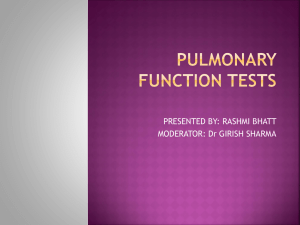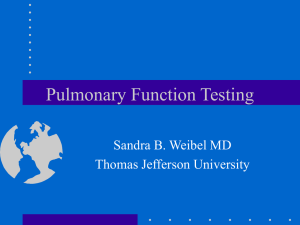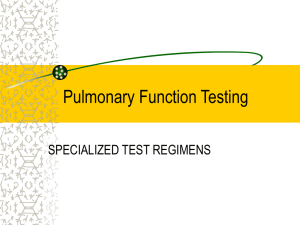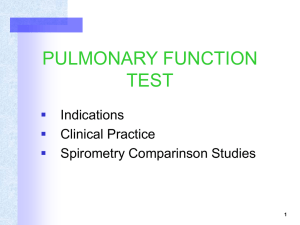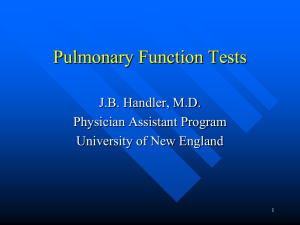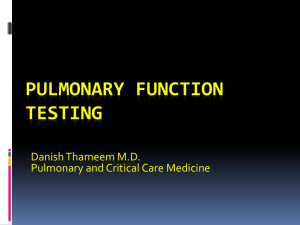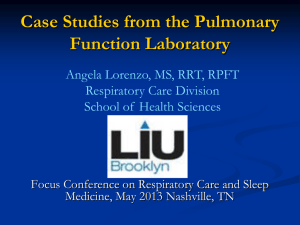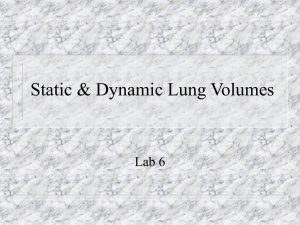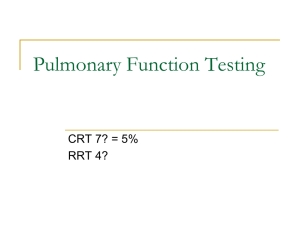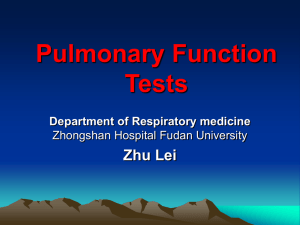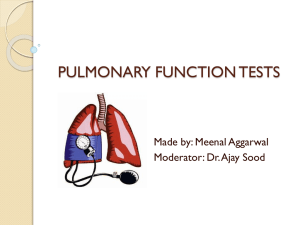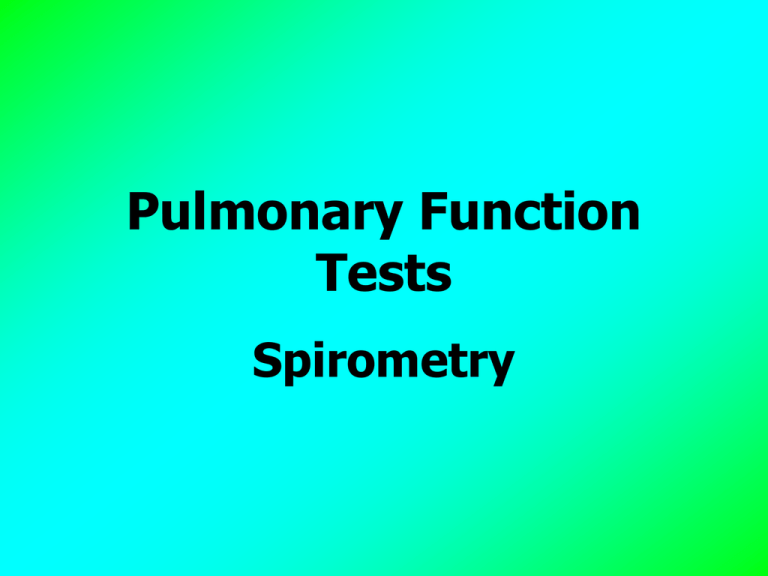
Pulmonary Function
Tests
Spirometry
COPD
The most common respiratory disease
• One of the leading causes of death in the United Sates
•
Spirometry is the preferred test for the diagnosis of
COPD...
... the results must be correlated carefully with clinical
and rentgenographic data for optimal clinical application.
(Barreido TJ, Perillo I: An Approach to Interpreting Spirometry, AmFamPhysician2004;69)
The maneuver may be performed
in a forceful manner to generate
a forced vital capacity (FVC)
in a more relaxed manner to generate
a slow vital capacity (SVC)
In an expiratory tests we measure
how much air the patient can exhale after
a maximum inspiration (SVC test and FVC
test) and
how fast he/she can exhale it (FVC test)
(Slow) VITAL CAPACITY TEST
VC - Maximum volume of air expired from the point of maximum inspiration
VC EXP
Resting - end expiratory level
MEASUREMENT OF TLC
- impossible by a direct method /spirometry/!
(Closed-Circuit Helium Method)
Is the test normal?
• Effects of physical characteristics:
- Sex
- Age
- Height
- Weigh
• Sporting activity
Is the Test Normal ?
The patient`s results are compared to an average healthy subject of the
same age, height, gender, and ethnic group
value)
(predicted normal
Is the Test Normal ?
What is LLN?
Fixed value for the lower limit of normal
80% of predicted
What is the Range? - Setting the Threshold
„Publications on reference equations should include explicit definitions of the upper and
lower limits of the normal range, or provide information to allow the reader to calculate a lower
range”
„The ATS has recommended the use of lower limits of normal instead of the 80% of predicted
for setting the threshold that defines abnormal test results”. In normal spirometry, SVC, FVC,
FEV1, and FEV1 -to-FVC ratio are above the lower limit of normal.
The practice of using 80% predicted as a fixed value for the lower limit of normal may be
acceptable in children, but can lead to important errors when interpreting lung function in
adults. The practice of using 0.70 as a lower limit of the FEV1/FVC ratio results in a
significant number of false-positive results in males aged 40 yrs and females 50 yrs,
as well as in a risk of overdiagnosis of chronic obstructive pulmonary diseases (COPD) in
asymptomatic elderly never-smokers .
Because there is no absolute cut-off point for what is normal in biologic systems, an arbitrary
statistical approach is widely used to define the lowest 5% of the population as abnormal .
The ATS recommends using the concept of lower limit of normal by identifying the lowest 5%
of a population (below the 5th percentile), or patients that fall outside the limits of 1.645 SD
from the mean. This value may be calculated by multiplying 1.645 times the standard error of
estimate (1.645 × SEE).
Is the Test Normal ?
What is LLN?
1. Fixed value for the lower limit of normal
80% of predicted
2. Values below the 5th percentile
Restrictive Pattern
A restrictive disease is like
a lock on the chest cage
or the elastic tissue of the lungs,
which limits the expansion of the lung,
thus interferes with respiration
It does not increase and may even
decrease the airway resistance,
but limits the lung volume from increasing
Restrictive Pattern
Thoracic cage abnormalities
Pleural disease
Neuromuscular involvement of the respiratory muscles
•
Alveolar filling processes
Interstitial diseases
Interstitial fibrosis
Pneumonia
Atelectasis
Restrictive pattern:
„less air in the lungs”
VC ?
RV ?
FRC ?
TLC ?
Restrictive pattern:
Restrictive pattern
- Always reduced VC
- Always reduced TLC
Narrowing of lumen
of the airways
• airway resistance
• flow rate
Airway resistance:
8l
R = r4
- If r decreases by the factor of 4,
the resistance will increase by a factor 256
Airflow:
.
V=
P
R
• airway resistance
• rate at which air can move through the lungs
Asthma
Chronic bronchitis
Emphysema
COPD
(Obstruction of lower airways)
Rapid and forced breathing accentuates the airway narrowing
FORCED (Expiratory) VITAL CAPACITY TEST
A VOLUME /TIME CURVE
A fast rise
A plateau at the end
Forced Expiratory Vital Capacity Test
A VOLUME /TIME CURVE
A NORMAL VOLUME/TIME CURVE
FORCED (EXPIRATORY) VITAL CAPACITY TEST
FEV 1,0
Volume - Time
Curve
FVC
Fixed value for the lower limit of normal
The amount expired during the first second (FEV1) is
a constant fraction of the FVC, regardless of lung
size
FEV1 / FVC
or
FEV1 / VC
Fixed value for the lower limit of normal ?
A spirogram is a graphic representation of
bulk air movement depicted as a volume-time
tracing or as a flow-volume tracing.
Forced Vital Capacity Test (FVC)
Forced (Expiratory)
Vital Capacity Test
A Flow/Volume Curve
A triangle shape
with constant decline
FORCED (EXPIRATORY)
VITAL CAPACITY TEST
Flow - Volume Flow
Loop
• Flow rate?
Normal
Obstruction of lower airways
FEV1
?
VC
?
FVC
?
FEV1/(F)VC ?
FEV1 [L] -
Reduced
OBSTRUCTION
VC?
FVC?
Air trapping pseudorestriction
Normal
Reduced
N
Obs
FVC [l]
3.11
2.93
FEV1 [l]
2.76
1.67
FEV1/FVC
0.87
0.
%Obs/N
64%
N
FEV 1
FEV1/FVC
[l] 2,28
0.73
Obs %Obs/N
1,55
68
0.57 78
FVC
[l] 3,11
2,71
87
PEF
[l/s] 5,78
4,90
85
FEF 25- 75
[l/s] 2,56
0,59
23
VC
?
RV
?
FRC
?
TLC
?
Obstruction - Other Volumes and Capacities
NORMAL
- Air trapping:
- Hyperinflation:
Obstruction Of Upper Airway, Trachea, Large Bronchi less common , can be suggested by spirometry
Variable
(airflow is compromised by dynamic changes in airway diameter)
Reasons
Intrathoracic
Extrathoracic
Tracheomalacia
Neoplasm
Vocal cords paralysis,
Thyromegaly Tracheomalacia
Neoplasm
Flat expiration
Flat inspiration
Obstruction Of Upper Airway, Trachea, Large Bronchi less common , can be suggested by spirometry
Fixed
Reasons
Intrathoracic
Extrathoracic
Tracheal stenosis
Foreign body Neoplasm
Flow/Volume Curve is flat for inspiration and expiration
(a squared loop)
A specific, but not sensitive sign
FORCED VITAL CAPACITY TEST
Restrictive Pattern
„Less air in the lungs”
FVC ?
FEV1 ?
FEV1to FVC ratio ?
FEV1 [L] -
Reduced
F(VC) [L] - Reduced
FEV1 reduced less than F(VC)
FEV1 to (F)VC ratio - NORMAL
RESTRICTION
or INCREASED
N
Flow - volume curve:
FEV 1
[l] 1,90
0.7
Obs %Obs/N
0.98
49
140
0,94
• shape - relatively unaffected
FEV1/FVC
• overall size - appears when
FVC
[l] 2,75
0,96
35
compared to normal on the
PEF
[l/s] 5,40
2,98
55
same curve
FEF 25- 75
[l/s] 2,11
2,25 107
?
Obstructive changes with reduced VC (additional
concurrent restriction?)
MEASUREMENT OF TLC
- impossible by a direct method /spirometry/ !
MEASUREMENT OF RV (FRC, TLC) -
INDIRECT !
(Closed-Circuit Helium Method)
The Closed - Circuit Helium Method
Method -rebreathing from the closed circuit to the point of stabilization of
helium concentration.
Start of the test - at the end of quiet expiration
The total amount of helium does not change
F1 x V1 = F2 x (V1+FRC)
Residual volume can be determined by a
spirometric helium dilution technique.
V2 =
V1 (C1-C2)
C2
C1
V1
C2
V1 – initial volume of the system (apparatus)
F1 – initial concentration of helium
F2 – final concentration of helium
V1+FRC – final volume of the system (apparatus + FRC)
V2
Before equilibration
After equilibration
Slide 14
The Closed - Circuit Helium Apparatus
The Closed - Circuit Helium Method
• Helium is insoluble and not taken up by blood
• The subject is connected with the spirometer filled with 10% helium in air.
• Method - rebreathing from the closed circuit to the point of stabilization of helium
concentration - The total amount of helium does not change
(The helium concentration in the lungs becomes the same
as in the spirometer after the subject rebreathes the
helium-air mixture).
If the test starts at the end of normal expiration – the
amount of air remaining in the lungs represents FRC
If the test starts at the end of deepest expiration – the
amount of air remaining in the lungs represents RV
F1 x V1 = F2 x (V1+FRC)
FRC =
V1 (F1-F2)
F2
V1 – initial volume of the system (apparatus)
F1 – initial 10% concentration of helium in the apparatus
F2 – final concentration of helium (after equilibration)
V1+FRC – final volume of the system (apparatus + FRC)
2. The Nitrogen Washout Method
Apparatus: open - circuit
Method: collection of air expired during breathing 100% O2 (7`)
Start of the test - at the end of quiet expiration
Parameters known
or measured:
- Concentration of nitrogen in the lungs
- Concentration of nitrogen in expired gas
- Volume of expired gas,
Parameter unknown: - Volume of gas in the lungs = FRC
The total amount of nitrogen in the lung at the begging of the test
equals the amount of nitrogen collected in the bag.
Concentration of nitrogen in the lungs
x Volume of gas in the lungs
Concentration of nitrogen in expired gas x Volume of expired gas
=
The following spirogram was obtained from a 23-year-old woman, who was asked to inspire maximally (A to B)
and then to expire maximally (from B to C).
1.
The forced vital capacity (FVC) is
A.
500 ml
B.
2000 ml
C.
4000 ml
D.
5500 ml
E.
Cannot be determined
2. The forced expiratory volume (FEV1) in 1 second is
A.
500 ml
B.
2200 ml
C.
3000 ml
D.
5500 ml
E.
Cannot be determined
3. The residual volume (RV) is
A. 1000 ml
B. 1500 ml
C. 1200 ml
D. One half the functional residual capacity
E. Cannot be determined
The following spirogram was obtained from a 23-year-old woman, who was asked to inspire
maximally (A to B) and then to expire maximally (from B to C).
1.
The forced vital capacity (FVC) is
A.
500 ml
B.
2000 ml
C.
4000 ml
D.
5500 ml
E.
Cannot be determined
2. The forced expiratory volume (FEV1) in 1 second is
A.
500 ml
B.
2200 ml
C.
3000 ml
D.
5500 ml
E.
Cannot be determined
3. The residual volume (RV) is
A. 1000 ml
B. 1500 ml
C. 1200 ml
D. One half the functional residual capacity
E. Cannot be determined
The spirogram of the forced vital capacity (FVC) was obtained from a male patient
weighting 70 kg.
4. The forced expiratory volume in 1 second (FEV1)
to FVC ratio is
A.50%
B.75%
C.80%
D.100%
E.Not able to be determined
5. The FEV1 to FVC ratio is typical of
A.healthy individuals
B.a restrictive pattern of pulmonary disease
C.an obstructive pattern of pulmonary disease
D.patients with interstitial pulmonary fibrosis
E.pulmonary edema
6. Which of the following statements about this
patient is true?
A. Had the FRC been measured, it would have
been less than predicted
B. Had the TLC been measured, it would have
been less than predicted
C. Had the RV been measured, it would have
been less than predicted
D. The expiratory flow rate (liters/s) is greater
than predicted
E. None of them
The spirogram of the forced vital capacity (FVC) was obtained from a male patient
weighting 70 kg.
4. The forced expiratory volume in 1 second
(FEV1) to FVC ratio is
A.50%
B.75%
C.80%
D.100%
E.Not able to be determined
5. The FEV1 to FVC ratio is typical of
A.healthy individuals
B.a restrictive pattern of pulmonary disease
C.an obstructive pattern of pulmonary disease
D.patients with interstitial pulmonary fibrosis
E.pulmonary edema
6. Which of the following statements about this
patient is true?
A. Had the FRC been measured, it would have
been less than predicted
B. Had the TLC been measured, it would have
been less than predicted
C. Had the RV been measured, it would have
been less than predicted
D. The expiratory flow rate (liters/s) is greater
than predicted
E. None of them
7. Which one of the following would increase in obstructive, but not in restrictive, lung disease?
A. FEV1
B. FEV1/FVC
C. Vital capacity
D. Functional residual capacity
E. Breathing frequency
8. Which of the following conditions is most likely to produce the change from the normal maximum
flow-volume curve illustrated below?
A. Asthma
B. Emphysema
C. Bronchiolitis
D. Fibrosis
E. Fatigue
9.Which one of the followings will be closest to normal in a patient with restrictive lung disease?
A. RV
B. VC
C. FVC
D. FEV1/FVC
E. TLC
7. Which one of the following would increase in obstructive, but not in restrictive, lung disease?
A. FEV1
B. FEV1/FVC [%]
C. Vital capacity
D. Functional residual capacity
E. Breathing frequency
8. Which of the following conditions is most likely to produce the change from the normal
maximum flow-volume curve illustrated below?
A. Asthma
B. Emphysema
C. Bronchiolitis
D. Fibrosis
E. Fatigue
9.Which one of the followings will be closest to normal in a patient with restrictive lung disease?
A. RV
B. VC
C. FVC
D. FEV1/FVC
E. TLC
Questions 10-12. The information which follows was obtained from a 23-year-old patient during a
complete work-up (direct spirometry; closed circuit helium method) in a pulmonary function
laboratory:
Total lung capacity
7.0 L
Inspiratory capacity
4.0 L
Inspiratory reserve volume
3.5 L
Expiratory reserve volume
1.5 L
10. The tidal volume (TV) is
A. 100 ml
B. 350 ml
C. 500 ml
D. 1000 ml
E. cannot be determined given the above data
11. The vital capacity (VC) is
A. 3.0 L
B. 5.0 L
C. 5.5 L
D. 6.0 L
E. 7.0 L
12. The functional residual capacity (FRC) is
A. 0.5 L
B. 3.0 L
C. 3.5 L
D. 4.0 L
E. not measurable given the above data
Questions 10-12. The information which follows was obtained from a 23-year-old patient during a
complete work-up (direct spirometry; closed circuit helium method) in a pulmonary function
laboratory:
Total lung capacity
7.0 L
Inspiratory capacity
4.0 L
Inspiratory reserve volume
3.5 L
Expiratory reserve volume
1.5 L
10. The tidal volume (TV) is
A. 100 ml
B. 350 ml
C. 500 ml
D. 1000 ml
E. cannot be determined given the above data
11. The vital capacity (VC) is
A. 3.0 L
B. 5.0 L
C. 5.5 L
D. 6.0 L
E. 7.0 L
12. The functional residual capacity (FRC) is
A. 0.5 L
B. 3.0 L
C. 3.5 L
D. 4.0 L
E. not measurable given the above data
Thank you

